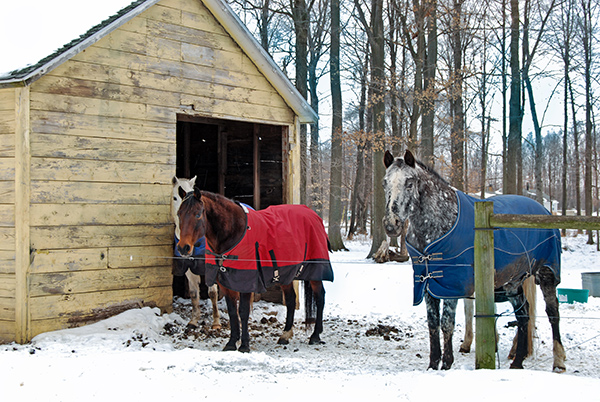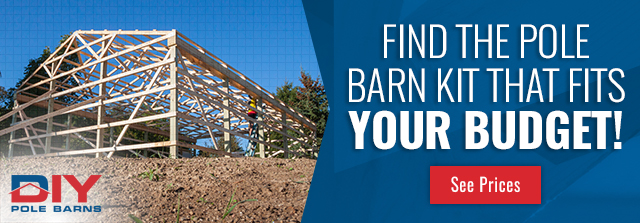Snow is falling, trees are bare, and the frigid winds are biting. Horses are no stranger to the cold, but keeping them comfortable is an important part of being a responsible horse owner. You want to ensure their health while protecting them from the extreme elements. There are plenty of ways to fight the cold, including small horse barns, blankets and even their natural defenses from the elements.
Read on to learn how to plan an ideal pole barn for horses in the winter, along with other tips that can keep them from being left out in the cold.
Planning Your Small Horse Barn
If you don’t currently have a small horse barn for your steeds, there are a few things to consider when planning to build your pole barn.
Prevailing Winds
Drafts in a pole barn can undermine the shelter they offer to your horses. While ventilation is important, you want to prevent undesired chills, snows or sleet from blowing through during the colder nights of the year. Position your pole barn to face away from the prevailing winds.
Remember to spend some time during the planning stages investigating the area you intend to build your barn. While the winds may typically come from one direction, obstructions on the property can change the way they’ll hit your barn.
Use the Sun to Your Advantage
If you position your roof correctly to take advantage of the sun’s natural warmth, you can dramatically increase how comfortable your barn is for your horses. This is true even during the winter!
Many modern homesteaders use solar panels to further improve the self-sufficiency of their land. If you’re considering this, even down the road, it’s much easier to design your pole barn to maximize its sun exposure now than rebuilding it years later. Even if you don’t add solar panels, you can help add a few degrees of warmth during the chilliest days of December or January.
Pole Barn Insulation
Any livestock barn should be well-insulated to help fight against the oncoming cold during the winter. There are several types of insulation that are well-suited to keeping your pole barn temperature controlled. If you’re not sure where to start, read our guide on pole barn insulation!
Ensure Proper Ventilation
Few things in a pole barn for horses are as important as adequate airflow. Whether it’s during the winter or the summer, airflow is necessary to promote a healthy respiratory system for horses of any size. Poor ventilation is a common mistake during construction of barns – especially those for horses and livestock.
There are many ways to plan proper ventilation, but the most common way to do it is using the system of estimating how many times the air changes per hour, or ACH. ACH is calculated by factoring how frequently the full volume of air in a barn is replaced each hour. To reduce buildup of moisture, ammonia and mold spore contamination, the idea ACH for your barn should be around five or six.
Adequate airflow can feel like it’s allowing cold drafts to affect your horses. While you want to avoid extreme temperatures, remember horses can withstand drafts a few degrees colder than people – especially horses properly conditioned for the winter. Don’t sacrifice healthy ventilation by tightly sealing off your barn!
When you have a good ventilation system, it will also help keep your horses cooler in the summer too!
Winterizing an Existing Horse Barn
Prep Your Water
No matter the season, your horses need water. During the winter, you may use anything from heated troughs to heated buckets or maybe an automatic watering system. It’s important to check these early and check them often.
Any power cords should be inspected, water lines should be checked and you should test the heating method frequently. Your water won’t be any use to your horses if it’s frozen solid!
Check for Leaks & Roof Damage
Before the full force of winter arrives, take some time to examine the interior and exterior of your pole barn’s roof. Any leaks or damage can be best repaired now instead of when they cause problems after a heavy snow.
Depending on the roof of your barn, it’s possible that vines, limbs or even just the wind could have lifted sections of metal on your roof. Protecting your horses from rain and snow is one of the key benefits to using a horse barn – make sure you’re not letting precipitation sneak in through the cracks!
Clean Gutters & Install Snow Slides
You don’t want to have to deal with frozen barn doors. Snow accumulation on your barn can turn into a big problem if it’s not properly managed. Cleaning your gutters should be one of the first things you do when winterizing your small horse barn. If it’s not too cold out yet, you can power wash them to remove small debris after you’ve manually removed bigger sticks or leaf piles.
Any pole barn is designed to handle an appropriate snow load for your region. But keeping snow off your roof will be the best way to avoid collapses and other problems. Snow bars are a fantastic way to keep snow from accumulating and falling off in big piles – which can be a risk to yourself or your horses.
Should You Blanket Your Horse?

Many wonder if they should blanket their horse every winter. Some horse owners believe that a blanket is necessary, but the reality is that in most cases, the horse’s natural coat is more than enough to protect them from the freezing air. In fact, when it’s simply cold out, healthy horses can withstand temperatures down into the single digits.
There are circumstances that necessitate blanketing your horse. For instance, older horses or those that aren’t in perfect health will have trouble withstanding extreme temperatures. More commonly, rain during the colder seasons of the year can be particularly harsh on even the healthiest horses.
If your horse doesn’t have proper shelter, frigid winds should be your biggest concern. This is why windbreaks are necessary during the winter.
The best solution to protect your horses will be building a small horse barn. Not only can they help insulate them against the cold, it also stops wind and rain, the two biggest risks during the winter.
Don’t Forget to Adequately Feed Your Horse
Even with a small horse barn, your horse relies on fat to maintain a healthy body temperature. That means extra hay and grain to help give them the calories they need to build some bulk to insulate them against the freeze.
Every horse will have unique needs, so adjust accordingly. In some cases, fat additives like rice bran or its extract can add fat to their diets when the winter is expected to be especially frigid.
Design the Perfect Small Horse Barn – Get an Instant Quote Online!
If you’re ready to build your pole barn, lock in a quote with DIY Pole Barns using our Instant Quote tool! Have questions? Call our knowledgeable staff at (937) 547-9100.
Connect with us on social media!




